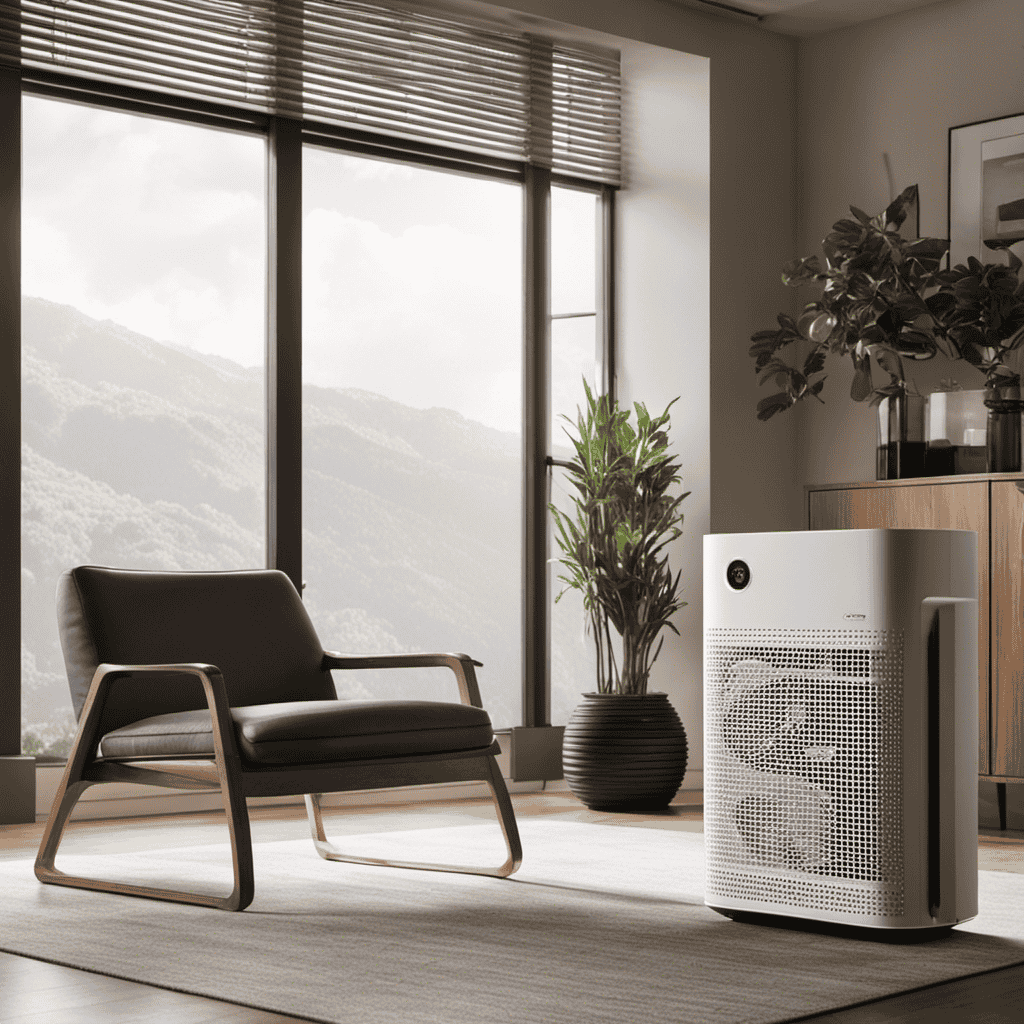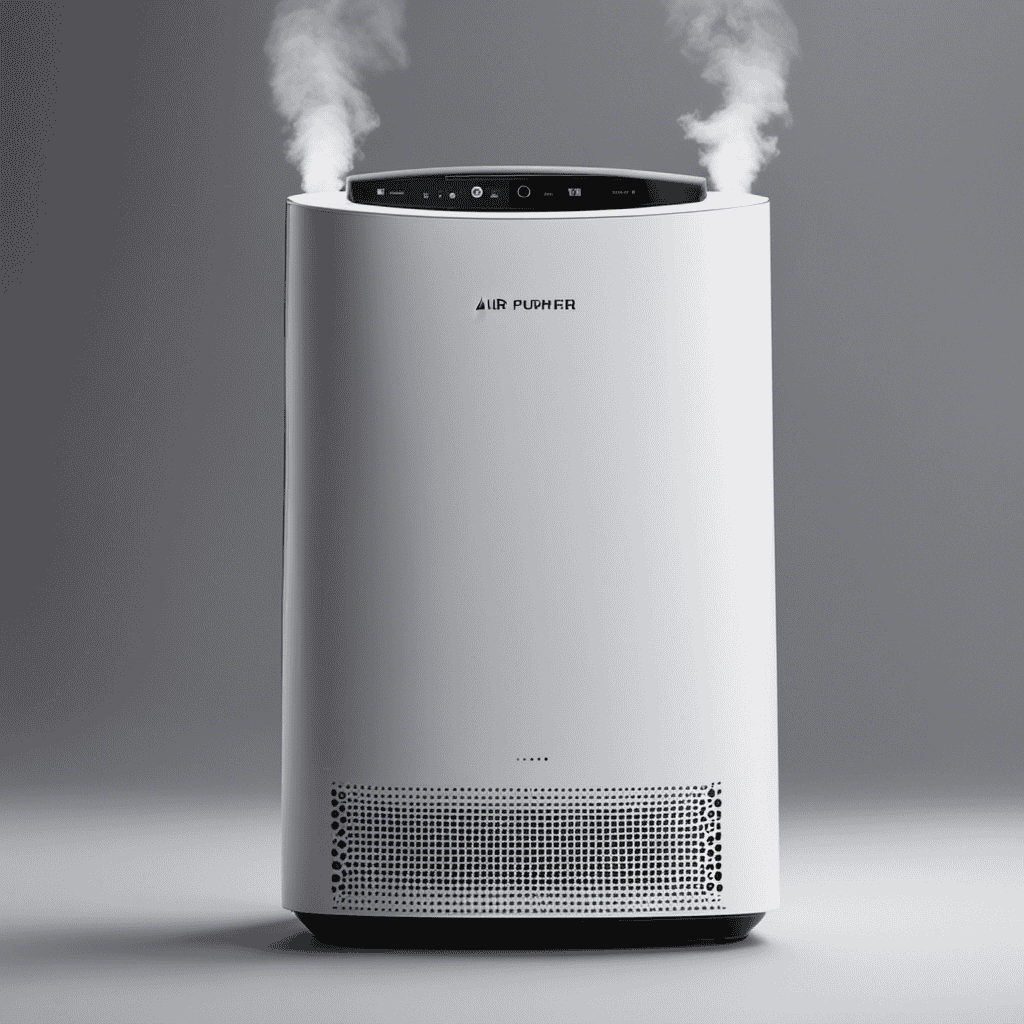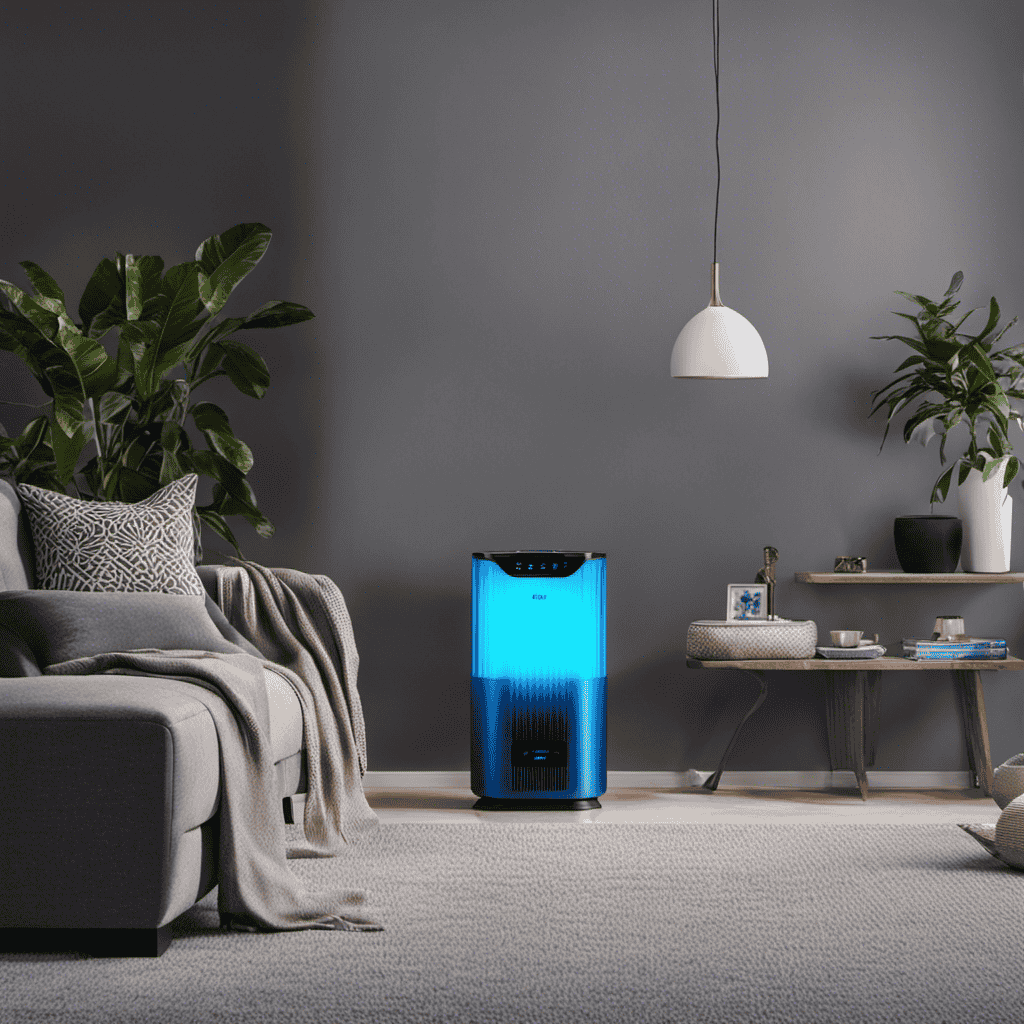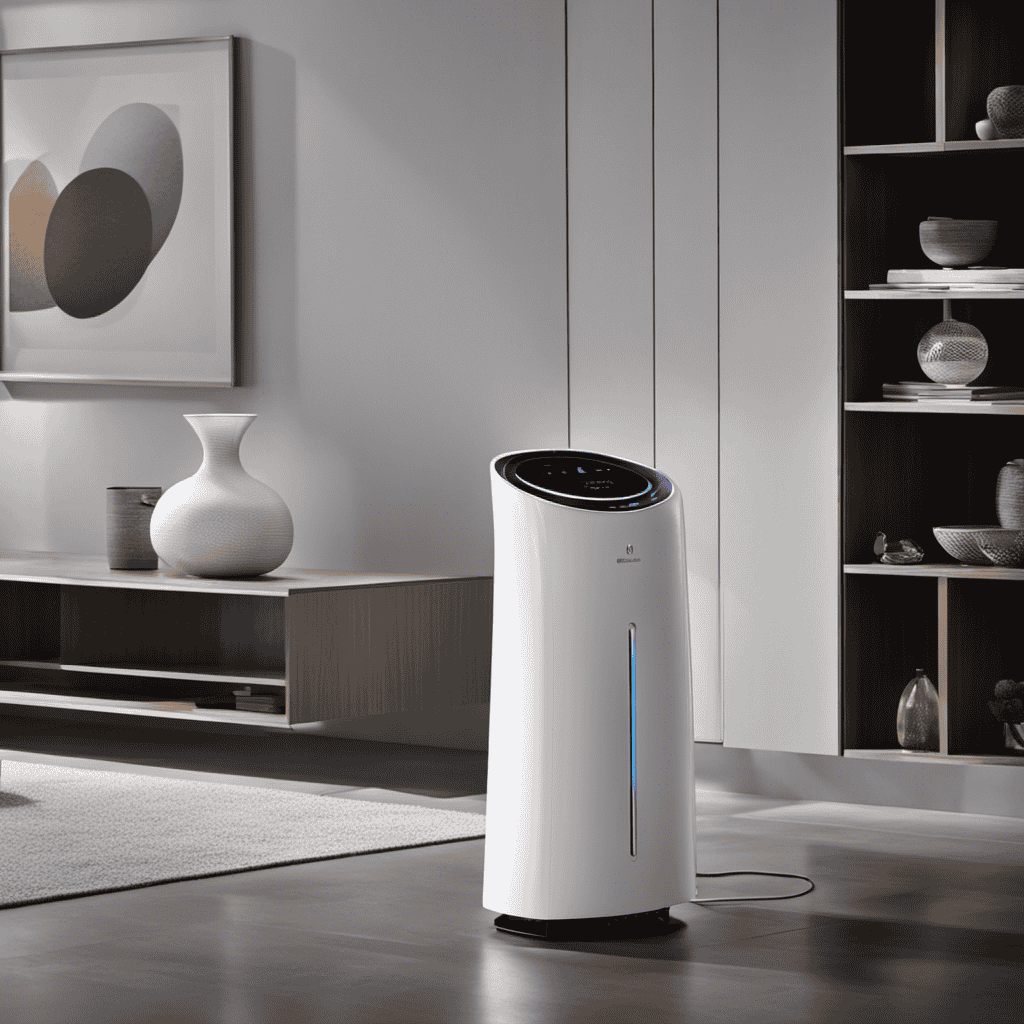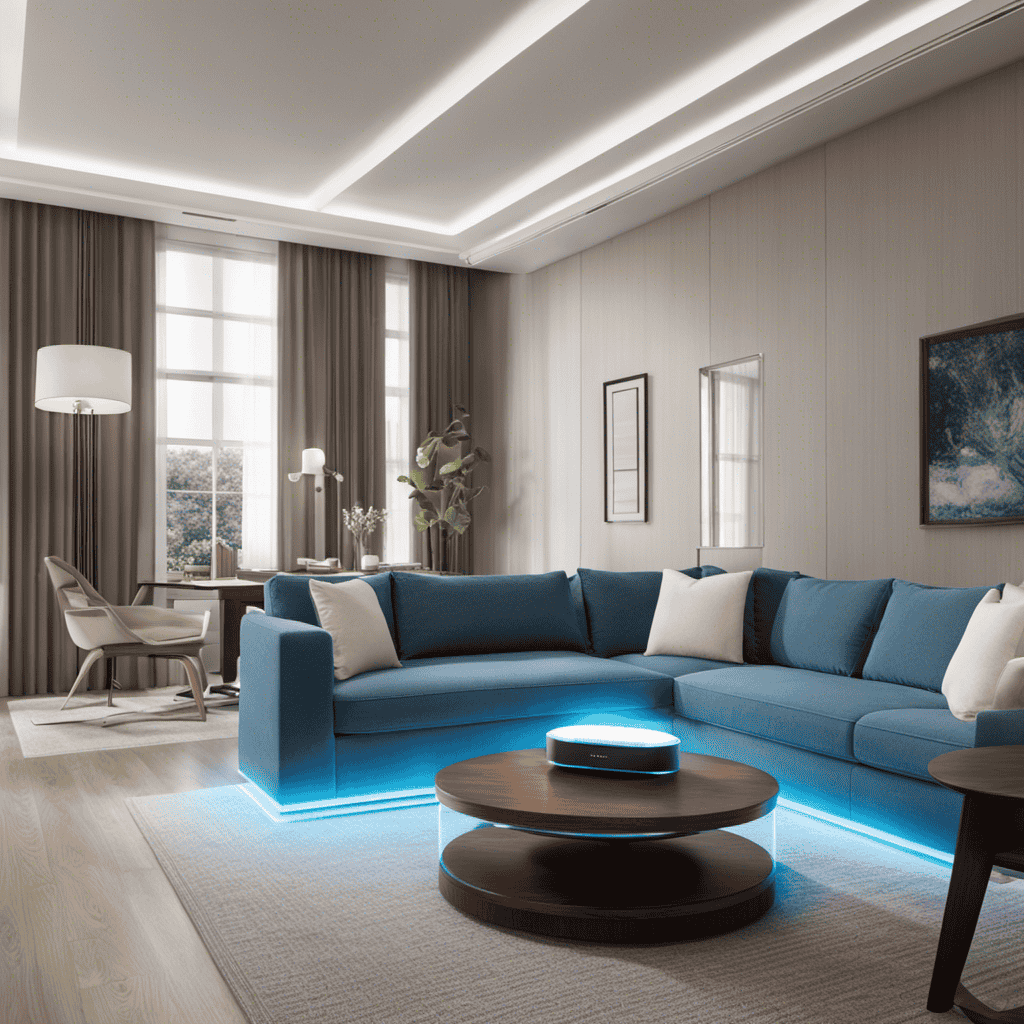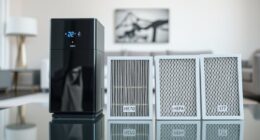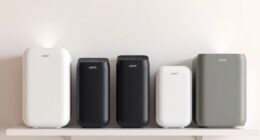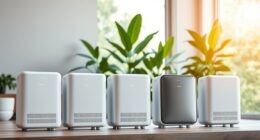Did you know that indoor air can be five times more polluted than outdoor air? That’s why it’s essential to have an air purifier in your home.
But here’s the thing – placement matters. In this article, I’ll guide you on which way to face your air purifier for maximum effectiveness.
We’ll explore the importance of proper placement, factors to consider, and common mistakes to avoid.
So let’s dive in and optimize the air quality in your living space.
Key Takeaways
- Proper placement of an air purifier is crucial for maximizing its effectiveness in improving indoor air quality.
- Proximity to pollutant sources enhances the filtration efficiency of the air purifier.
- Good air circulation, achieved through placing the purifier in high-traffic areas and avoiding obstructions, ensures better overall air quality.
- The layout of the room, including its size, shape, and furniture placement, can impact air circulation and should be considered when determining the placement of the air purifier.
Importance of Proper Placement
You should ensure that you’re placing the air purifier in the correct position to maximize its effectiveness. Understanding air quality and the benefits of proper ventilation is crucial in achieving a healthy indoor environment.
By placing the air purifier in the right position, you can effectively remove pollutants and improve the air quality in your home or office.
One important aspect to consider is the proximity to the source of pollutants. If you have a specific area that tends to have more pollutants, such as a kitchen or a smoking area, it’s best to place the air purifier nearby to capture and filter those pollutants efficiently.
Additionally, you should also consider the airflow in the room. Placing the air purifier in an area with good air circulation will help distribute the clean air throughout the space more effectively, resulting in better overall air quality.
Understanding Air Flow Patterns
Understanding the airflow patterns helps in determining the most effective placement for an air purifier. By understanding airflow dynamics and the impact of room size on air circulation, we can optimize the effectiveness of our air purifiers.
Here are five factors to consider when analyzing airflow patterns:
-
Obstructions: Identify any furniture, curtains, or other objects that may impede the airflow and hinder the purifier’s performance.
-
Vents and Windows: Take note of the location of vents and windows, as they can influence the direction of air movement in the room.
-
High-Traffic Areas: Consider placing the air purifier in areas with high foot traffic, as this can help circulate and filter the air more efficiently.
-
Air Conditioning and Heating Systems: Understand how these systems impact the airflow in the room and adjust the placement of the purifier accordingly.
-
Room Size: Larger rooms may require multiple air purifiers strategically placed to ensure optimal air circulation.
Factors to Consider for Placement
When it comes to ensuring optimal air circulation and eliminating potential pollutants in your living space, there are a few key points to consider.
First, it’s important to place your air purifier in a strategic location that allows for proper air flow throughout the room. This ensures that the purifier can effectively capture and filter the air.
Additionally, it’s crucial to identify and eliminate potential sources of pollutants, such as smoke, pet dander, or volatile organic compounds (VOCs), to maintain a clean and healthy indoor environment.
Optimal Air Circulation
To maximize air circulation, it’s best to position the air purifier in a central location in the room. This placement ensures that the purified air can reach all corners of the space, maximizing efficiency and improving indoor air quality. Here are five key factors to consider when optimizing air circulation with your air purifier:
- Distance from walls: Keep the air purifier at least a foot away from walls to allow adequate airflow.
- Avoid obstructions: Place the purifier away from furniture or other objects that could block the air path.
- Elevation: Position the purifier at a higher level to allow the clean air to disperse evenly throughout the room.
- Directionality: Face the air purifier towards the center of the room to maximize air distribution.
- Multiple units: In larger rooms, consider using multiple air purifiers strategically placed for optimal coverage.
Eliminating Potential Pollutants
One way you can effectively eliminate potential pollutants is by regularly cleaning and maintaining your air purifier. Proper maintenance is crucial to ensure that your air purifier continues to work efficiently in improving the air quality in your home and promoting better health.
Regular cleaning of the filters, as recommended by the manufacturer, helps to remove accumulated dust, allergens, and other pollutants from the air. This not only improves the performance of the air purifier but also ensures that the purified air remains clean and healthy.
Facing the Air Purifier Towards the Source of Pollution
Facing the air purifier towards the source of pollution helps to effectively remove contaminants from the air. When positioned towards windows, the air purifier can capture pollutants that enter the room through open windows or seep in from outside. This prevents them from circulating and spreading throughout the space.
Additionally, facing the air purifier towards plants can have numerous benefits. The plants act as natural air purifiers, absorbing carbon dioxide and releasing oxygen while also removing volatile organic compounds (VOCs) from the air. This combination of the air purifier and plants working together creates a cleaner and healthier indoor environment. It not only improves air quality but also enhances the aesthetic appeal of the space.
Overall, positioning the air purifier strategically can maximize its efficiency and contribute to better indoor air quality.
- Trapping pollutants from entering through open windows
- Preventing pollutants from spreading throughout the room
- Utilizing the natural air purification ability of plants
- Enhancing the aesthetic appeal of the space
- Creating a cleaner and healthier indoor environment
Considering the Layout of the Room
When it comes to optimizing air circulation in a room, considering factors such as room size, shape, and furniture placement is crucial. These three key points play a significant role in determining how efficiently air can flow throughout the space, ultimately impacting the overall air quality.
Research suggests that proper air circulation can help reduce the concentration of pollutants, allergens, and other airborne particles, creating a healthier indoor environment.
Optimal Air Circulation
To ensure optimal air circulation, it’s important to position the air purifier in a way that allows air to flow freely throughout the space. Here are some tips to maximize efficiency and improve indoor air quality:
- Place the air purifier in a central location in the room to ensure even airflow.
- Avoid placing the air purifier against a wall or in a corner, as this can restrict airflow.
- Keep the air purifier at least a few feet away from furniture or other objects to prevent obstruction of airflow.
- If possible, position the air purifier near a window or door to take advantage of natural ventilation.
- Consider the size of the room when determining the placement of the air purifier, as larger rooms may require multiple units for effective air circulation.
Room Size and Shape
For optimal air circulation in your room, make sure to consider the size and shape of the space. These factors play a crucial role in determining the effectiveness of air circulation and can greatly impact the overall comfort and well-being of the occupants.
When it comes to room lighting, it is important to choose the right type and intensity of light for your specific needs. Bright, natural light can enhance the ambiance and make the room feel more spacious, while dimmer, warmer lighting can create a cozy and relaxing atmosphere.
Additionally, noise levels should also be taken into consideration. Excessive noise can be disruptive and affect the quality of sleep and relaxation. Choosing noise-cancelling curtains or soundproofing materials can help create a more peaceful environment.
Furniture Placement Impact
Consider rearranging your furniture to optimize air circulation and create a more comfortable living space. Furniture arrangement plays a crucial role in determining the direction of airflow in a room.
Here are five key factors to consider when arranging your furniture:
- Position couches and chairs away from vents or fans to prevent blocked airflow.
- Place furniture perpendicular to windows to allow air to circulate freely.
- Avoid placing large pieces of furniture against walls, as this can obstruct airflow.
- Create clear pathways between furniture to promote better air circulation.
- Use furniture with open designs, such as bookshelves with gaps, to allow air to flow through.
Effects of Facing the Air Purifier Towards Walls
Facing the air purifier towards walls can reduce its effectiveness in purifying the air. Research suggests that proper air circulation is crucial for optimal performance. When an air purifier is positioned facing a wall, it restricts the flow of air and limits its ability to capture pollutants effectively.
The ideal placement is to position the air purifier away from walls and towards the center of the room. This allows for better air circulation, ensuring that the purifier can effectively draw in and filter the air in the entire space. It is also recommended to keep the purifier at a certain distance from furniture and other obstacles to allow for unobstructed airflow.
Benefits of Facing the Air Purifier Towards Occupied Areas
Positioning the air purifier towards occupied areas ensures that the clean air is directed towards the people in the room. This is important for maintaining indoor air quality and reaping the health benefits associated with clean air. Here are five reasons why facing the air purifier towards occupied areas is beneficial:
-
Improved respiratory health: By directing clean air towards occupants, it reduces the risk of respiratory issues caused by pollutants in the air.
-
Enhanced sleep quality: Breathing clean air during sleep can lead to better sleep quality, helping individuals wake up feeling refreshed and rejuvenated.
-
Increased productivity: Clean air can improve cognitive function and focus, leading to increased productivity and better overall performance.
-
Allergy relief: Facing the air purifier towards occupied areas can help remove allergens from the air, providing relief to allergy sufferers.
-
Reduced exposure to pollutants: By positioning the air purifier towards occupied areas, it ensures that individuals are not breathing in harmful particles, reducing their exposure to pollutants.
Overall, facing the air purifier towards occupied areas is crucial for the importance of clean air and the resulting health benefits it provides.
Avoiding Obstacles and Blockages
To ensure optimal airflow, make sure there are no obstacles or blockages in the path of the clean air from the air purifier to the occupied areas. By avoiding obstructions, you can maximize the airflow and ensure that the air purifier effectively cleans the air in your space. Obstacles such as furniture, curtains, or other objects can hinder the flow of air and reduce the efficiency of the air purifier. It is important to regularly check and clear any obstructions that may be blocking the airflow. By doing so, you can ensure that the air purifier can deliver clean and fresh air to the areas where it is needed the most.
To help you visualize the importance of avoiding obstructions, here is a table showing the impact of different obstacles on airflow:
| Obstacle | Impact on Airflow |
|---|---|
| Furniture | Blocks airflow, reduces effectiveness |
| Curtains | Restricts airflow, limits circulation |
| Objects | Disrupts airflow, decreases purification |
Optimizing Air Purifier Performance With Proper Placement
When it comes to optimizing the performance of an air purifier, proper placement plays a crucial role.
Finding the best placement for effectiveness involves considering factors such as the size of the room, the location of pollutants, and the type of air purifier being used.
Additionally, ideal positioning for airflow ensures that the air purifier can effectively draw in and distribute clean air throughout the space.
Lastly, understanding the impact of directional placement helps determine whether the air purifier should be positioned towards a specific area or in a more central location to maximize its effectiveness.
Best Placement for Effectiveness
Placing the air purifier near a source of pollution, like a window or door, can maximize its effectiveness. When considering the importance of airflow direction and the benefits of vertical placement, there are a few key factors to keep in mind:
-
Air circulation: Positioning the air purifier near a window or door allows it to capture pollutants as they enter the room, ensuring better air circulation.
-
Upward airflow: Placing the purifier vertically allows it to draw in contaminated air from the lower levels and release clean air at a higher point, promoting efficient circulation.
-
Optimal coverage: By positioning the air purifier in a central location, it can effectively cover a larger area and provide cleaner air throughout the room.
-
Reduced obstruction: Vertical placement helps to minimize obstructions and allows for better intake and distribution of air.
-
Enhanced filtration: When the air purifier is positioned vertically, it can take advantage of gravity, allowing larger particles to settle at the bottom and preventing them from recirculating in the room.
Considering these factors, it is important to find the ideal positioning for airflow to ensure maximum efficiency and effectiveness in purifying the air.
Ideal Positioning for Airflow
For optimal airflow, position your air purifier near a window or door to capture pollutants as they enter the room. This placement helps maximize efficiency and provides several health benefits.
When placed near a window or door, the air purifier can effectively capture outdoor pollutants, such as dust, pollen, and smoke, before they spread throughout the room. This not only improves the quality of the air you breathe but also reduces the workload on the purifier, allowing it to operate more efficiently.
Moreover, positioning the purifier near a window or door allows it to draw in fresh air from outside, further enhancing the air quality in your space.
Now, let’s explore the impact of direction placement on the effectiveness of your air purifier.
Impact of Direction Placement
To maximize the effectiveness of your air purifier, make sure it is positioned in a direction that allows for optimal airflow. The direction in which you place your air purifier can have a significant impact on allergies and indoor air quality.
Here are five important factors to consider:
-
Proximity to pollutants: Place your air purifier in a direction that is closest to the source of pollutants, such as a window or door.
-
Avoid obstructions: Ensure that there are no obstacles blocking the airflow, such as furniture or curtains.
-
Cross-ventilation: Position your air purifier in a way that allows for cross-ventilation, facilitating the circulation of clean air throughout the room.
-
Avoid corners: Avoid placing your air purifier in corners, as this can restrict airflow and reduce its effectiveness.
-
Height placement: Consider placing your air purifier at a height that allows for maximum air intake and distribution.
Common Mistakes to Avoid When Positioning an Air Purifier
Make sure you’re avoiding common mistakes when positioning your air purifier. It’s important to place your air purifier in the right direction to maximize its effectiveness in removing potential pollutants from the air.
One common mistake is placing the air purifier near walls or furniture, which can obstruct the airflow and reduce its efficiency.
Another mistake is positioning the air purifier too close to other electronic devices, as they can interfere with its operation.
It’s also important to avoid placing the air purifier in a corner or behind large objects, as this can hinder the circulation of clean air throughout the room.
Should I Face My Air Purifier a Certain Way Based on Its Location in the House?
The placement of basement air purifier is crucial for its efficiency. It should be faced towards the center of the room for better air circulation. If it’s in a corner, the airflow will be restricted, affecting its performance. Proper positioning ensures optimal air purification throughout the space.
Conclusion
In conclusion, placing your air purifier in the right direction is crucial for optimal performance. By understanding air flow patterns and considering factors such as the source of pollution, room layout, and occupied areas, you can effectively purify the air in your space.
Avoiding obstacles and blockages will further enhance the efficiency of your air purifier. Remember, proper placement is key to enjoying the full benefits of clean and fresh air.
So, take a moment to position your air purifier wisely and breathe easier.
